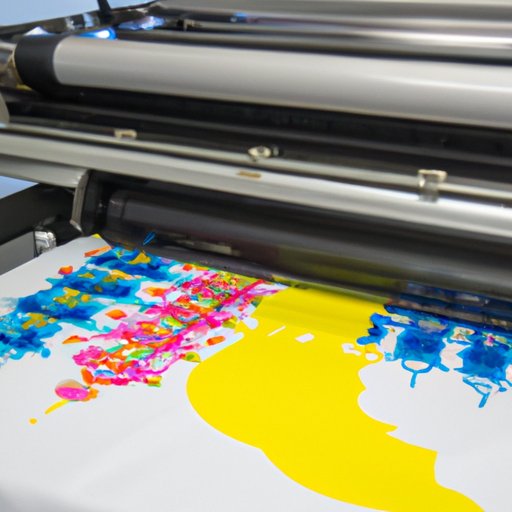Introduction
Sublimation printing is a popular form of digital printing that creates vibrant, high-resolution images with a sharp, crisp finish. It involves transferring an image onto a material using heat and pressure, creating a permanent bond between the two. It’s used to print on fabrics, ceramic mugs, phone cases, and more. In this article, we’ll explore the definition of sublimation printing, the benefits of using it, and how it works.
Exploring the Benefits of Sublimation Printing
Sublimation printing offers a wide range of benefits, making it a popular choice for creating custom products. Here are some of the main advantages:
Accuracy and Precision in Colors
One of the biggest benefits of sublimation printing is its accuracy and precision when it comes to colors. The inks used in the process are specially formulated to produce bright, vivid colors that won’t fade over time. This makes it ideal for printing logos, designs, and artwork that need to be as true to life as possible.
Durability of Printed Images
Another advantage of sublimation printing is the durability of the printed images. The inks are designed to bond permanently with the material they’re printed on, creating a long-lasting image that won’t crack, peel, or fade. This makes it perfect for printing items like t-shirts and mugs that need to look good for years to come.
Cost-Effective Process
Finally, sublimation printing is a cost-effective process. The materials used are relatively inexpensive, and the process itself doesn’t require a lot of time or energy. This makes it a great option for businesses looking to create custom products without breaking the bank.
A Step-by-Step Guide to Sublimation Printing
Now that you know the benefits of sublimation printing, let’s take a look at how the process works. Here’s a step-by-step guide to help you get started:
Prepping the Image
The first step is to prep the image you want to print. You’ll need to make sure it’s high-resolution and in the correct format for your printer. Most sublimation printers use either JPEG or TIFF files, so make sure your image is one of these formats before you begin.
Choosing the Right Paper
Next, you’ll need to choose the right type of transfer paper for your project. There are several different types available, so make sure you select one that’s compatible with your printer and the material you’re printing on. For example, if you’re printing on fabric, you’ll need a special type of transfer paper specifically designed for fabric.
Heating the Transfer Paper
Once you’ve selected the right paper, you’ll need to heat it up. This can be done with a heat press or an iron. Make sure the temperature is set correctly for the material you’re printing on. Too much heat can cause the image to burn or discolor, while too little heat won’t allow the ink to transfer properly.
Pressing the Image onto the Material
Now it’s time to press the image onto the material. Place the transfer paper onto the material with the printed side facing down. Then, use the heat press or iron to press the image onto the material. Once the image has been transferred, you can remove the transfer paper and admire your work!

Understanding the Science Behind Sublimation Printing
Before we move on to the next section, let’s take a quick look at the science behind sublimation printing. Understanding the chemical process involved can help you get the most out of your prints.
What Is Sublimation?
Sublimation is the process of changing a solid into a gas without passing through the liquid state. In sublimation printing, this occurs when the inks heated to a certain temperature turn into a gas and bond with the fibers of the material they’re printed on.
The Chemical Process Involved
The inks used in sublimation printing are made up of a combination of dyes, solvents, and other chemicals. When these inks are heated to a specific temperature, they turn into a gas and bond with the fibers of the material they’re printed on. This creates a permanent bond that won’t crack, peel, or fade over time.

A Comprehensive Guide to Sublimation Printing: What You Need to Know
Now that you understand the basics of sublimation printing, let’s take a look at what you need to know to get started. Here are some essential tips for optimizing your sublimation prints:
Different Types of Sublimation Printers
There are several different types of sublimation printers available on the market. Inkjet sublimation printers are the most common type, but there are also dye-sublimation printers that offer higher quality prints. Consider your needs and budget when selecting a printer.
Important Accessories
In addition to the printer, you’ll need a few accessories to get the most out of your sublimation prints. These include transfer paper, sublimation inks, and a heat press or iron. Make sure you have all of these items before you start printing.
Tips for Optimizing Your Sublimation Prints
Finally, here are some tips to keep in mind when printing your designs: use high-quality images, adjust the temperature and pressure of the heat press or iron, and don’t forget to add a protective coating to your finished product. Following these tips will help ensure your prints turn out perfect every time.
Conclusion
Sublimation printing is a great way to create custom products with vibrant colors and a sharp, crisp finish. It’s a cost-effective process that produces durable images that won’t fade over time. By understanding the definition, benefits, process, and science behind sublimation printing, you can get the most out of your prints. With the right equipment and a bit of practice, you’ll be able to create beautiful custom products in no time.
(Note: Is this article not meeting your expectations? Do you have knowledge or insights to share? Unlock new opportunities and expand your reach by joining our authors team. Click Registration to join us and share your expertise with our readers.)
